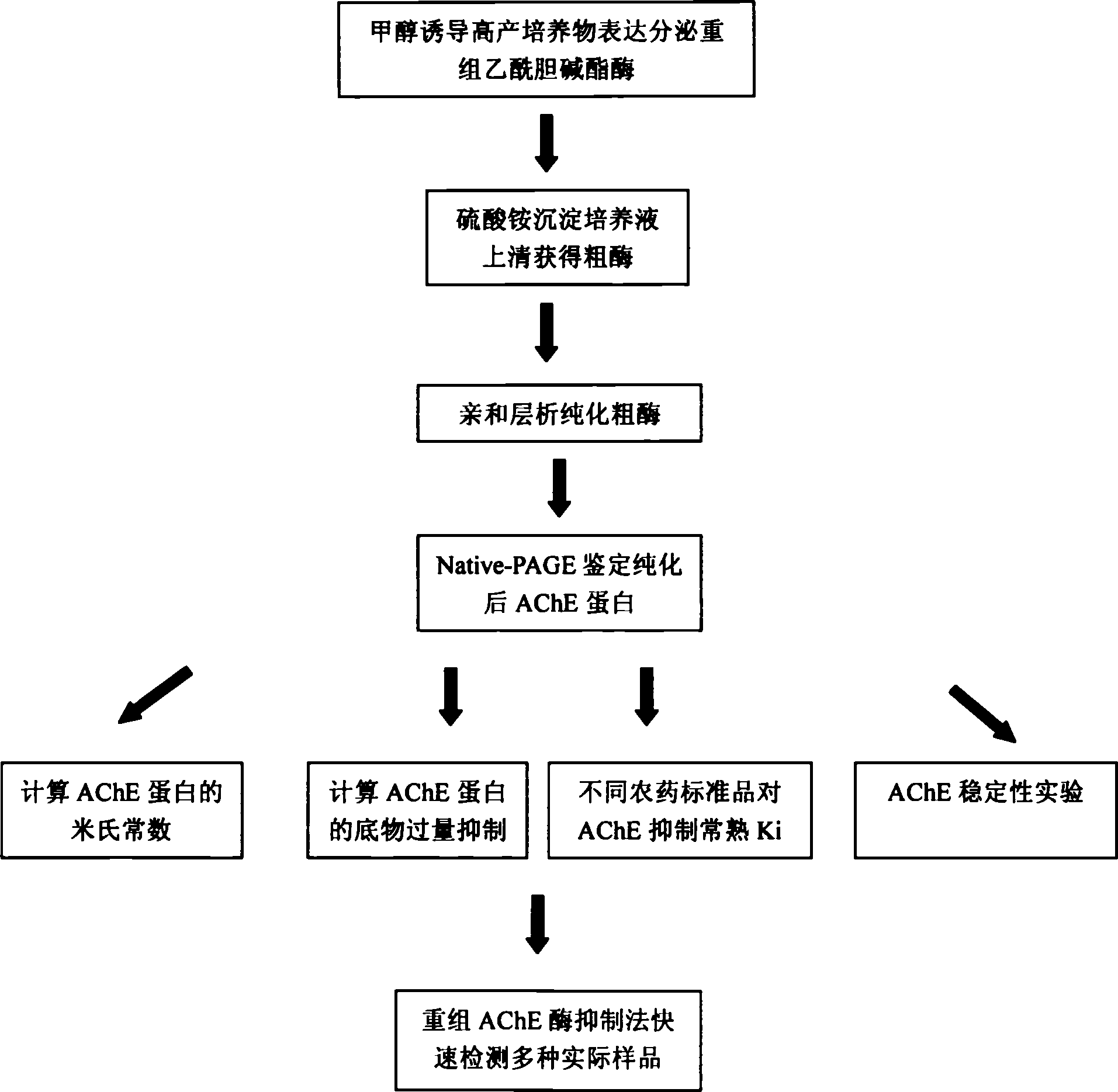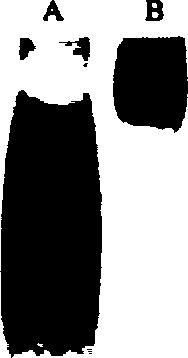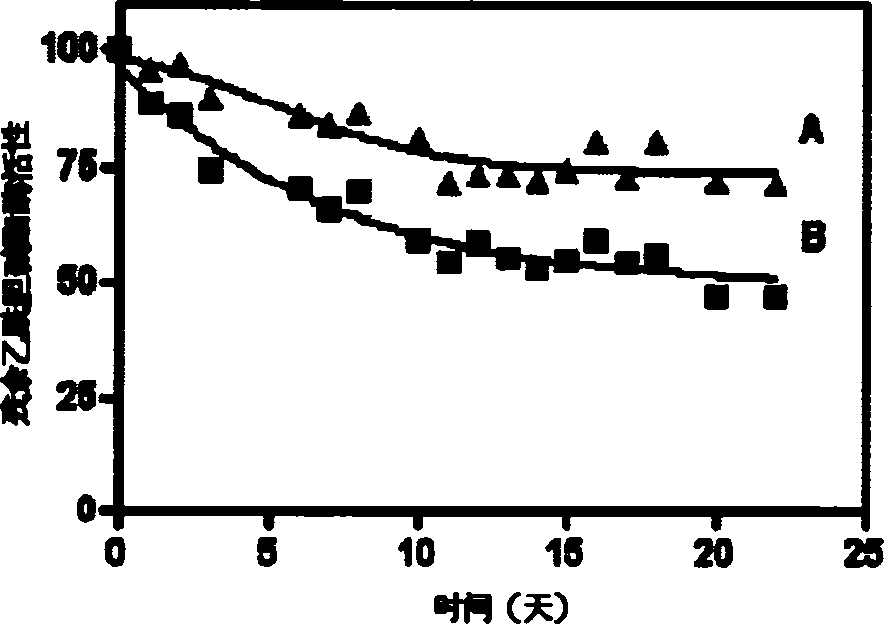Recombinat acetylcholinesterase and its prepn process and usage in detecting presticide residue
A technology for the detection of acetylcholinesterase and pesticide residues, which is applied in the field of recombinant acetylcholinesterase and its preparation and use in the detection of pesticide residues, and can solve the problems affecting the repeatability, purity and stability of test results, etc.
- Summary
- Abstract
- Description
- Claims
- Application Information
AI Technical Summary
Problems solved by technology
Method used
Image
Examples
Embodiment 1
[0097] Example 1 - The activity of yeast-expressed recombinant AChE protein was inhibited by trace amounts of dichlorvos
[0098] 1. Solutions and reagents
[0099] (1) BMGY solution
[0100] Dissolve 10g of yeast extract and 20g of peptone in 700mL of water, and sterilize by autoclaving (20min); after the solution temperature drops to room temperature, add 100mL of potassium phosphate buffer (1M, pH 6.0), 100mL of 10×YNB, 2mL of 500×B, and 100mL, respectively. 10×GY; the shelf life of the solution at 4°C is two months.
[0101] (2) BMMY solution
[0102] The 10×GY in the BMGY solution was replaced with 10×M, and the rest of the components remained unchanged. The shelf life of the solution at 4°C is two months.
[0103] (3) Dichlorvos solution
[0104] 0.11 g of dichlorvos (MW=220.98) crystals were weighed and dissolved in 5 mL of acetone. At this time, the concentration of dichlorvos was 0.1M. Dilute the solution in steps of 10 to 10 -5 , 10 -6 , 10 -7 M.
[0105] (...
Embodiment 2
[0117] Example 2 - The activity of yeast-expressed recombinant AChE protein was inhibited by trace amounts of chlorpyrifos
[0118] 1. Solution
[0119] (1) Chlorpyrifos solution
[0120] 0.175 g of chlorpyrifos (MW=350.6) crystals were weighed, dissolved in 5 mL of acetone, and the concentration of chlorpyrifos was 0.1M at this time. Dilute the solution in steps of 10 to 10 -5 , 10 -6 , 10 -7 M.
[0121] Remaining solutions and reagent formulations are the same as those in Example 1.
[0122] 2. Operation steps
[0123] The operation is basically the same as in Example 1. Dissolve chlorpyrifos crystals in acetone to a concentration of 10 -5 , 10 -6 , 10 -7 M's solution. 3 μl and 50 μl of the crude enzyme solution were respectively mixed and incubated (25° C., 15 min). At the same time, a control group was set up, which was composed of 3 μl of acetone mixed with 50 μl of crude enzyme solution. Add the mixture into the well of the microtiter plate containing 250μl El...
Embodiment 3
[0126] Embodiment 3---recombinant AChE protein detects carbowei in spinach
[0127] 1. Solution
[0128] (1) gram Budweiser solution
[0129] Dilute the 100 mg / L standard solution of carbofuran with acetone to 0.5, 0.25 and 0.05 mg / L.
[0130] Remaining solutions and reagent formulations are the same as those in Example 1.
[0131] 2. Operation steps
[0132] Cut 4g spinach into about 1cm with scissors 2 As for the small pieces in the beaker, add 4 mL of a certain concentration of carbocarb solution. After the solvent in the solution—acetone is completely volatilized, add 20 mL of 0.25 mM sodium phosphate solution (pH 8.0), ultrasonically shake (10 min), and take 4 mL of the sample. The extract was centrifuged in a 5 mL centrifuge tube (room temperature, 3000 rpm, 3 min), and 2.4 mL of the supernatant was collected. Add 40 μl of enzyme solution (about 30 U) to 2.4 mL of supernatant and place it in a water bath at 25°C for 15 min, transfer the mixture to a cuvette, add 100...
PUM
 Login to View More
Login to View More Abstract
Description
Claims
Application Information
 Login to View More
Login to View More - R&D
- Intellectual Property
- Life Sciences
- Materials
- Tech Scout
- Unparalleled Data Quality
- Higher Quality Content
- 60% Fewer Hallucinations
Browse by: Latest US Patents, China's latest patents, Technical Efficacy Thesaurus, Application Domain, Technology Topic, Popular Technical Reports.
© 2025 PatSnap. All rights reserved.Legal|Privacy policy|Modern Slavery Act Transparency Statement|Sitemap|About US| Contact US: help@patsnap.com



